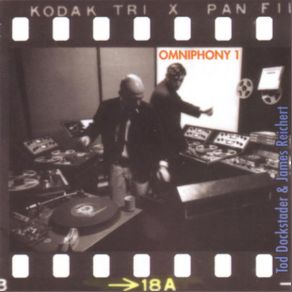Omniphony 1
Download links and information about Omniphony 1 by Tod Dockstader, James Reichert. This album was released in 2002 and it belongs to Electronica genres. It contains 7 tracks with total duration of 01:02:47 minutes.

|
|
|---|---|
| Artist: | Tod Dockstader, James Reichert |
| Release date: | 2002 |
| Genre: | Electronica |
| Tracks: | 7 |
| Duration: | 01:02:47 |
| Buy it NOW at: | |
| Buy on iTunes $9.99 | |
| Buy on Amazon $25.22 | |
Tracks
[Edit]| No. | Title | Length |
|---|---|---|
| 1. | Omniphony: Part One | 10:37 |
| 2. | Omniphony: Part Two | 9:56 |
| 3. | Omniphony: Part Three | 2:35 |
| 4. | Omniphony: Part Four | 6:43 |
| 5. | Omniphony: Part Five | 15:46 |
| 6. | Study No. 7 | 8:05 |
| 7. | Past Prelude | 9:05 |
Details
[Edit]"Omniphony 1," completed in 1966, could have been the avant-garde anthem of a generation. Instead it was more or less relegated to the status of novelty — and it's a shame. A groundbreaking collaboration between film score composer James Reichert and musique concrète/electronic composer Tod Dockstader, it attempted to fuse electronics with the orchestra in previously unheard of ways. Dockstader first produced a number of electronics cells, short-tape figures to be used for a new composition. Reichert wrote orchestral music to set them up. Once recorded, the orchestral tapes were then processed (reverb, echo, filters) in Bob Moog's studio, cut to pieces, and reassembled to produce the final work. So what listeners hear in the five movements of this new symphony (romantic in form) is bits of musique concrète, pure orchestra, and processed orchestra, with the lines getting very thin between these categories. It has the exuberance of Iannis Xenakis' electronic pieces, the raw sound of Edgar Varèse's "Déserts," and the quirkiness (some would call it a kitsch quality) of Perrey-Kingsley's mock sci-fi tunes. The first and last movements are stunning pieces of creativity in composition and assembly. The 45-minute work was first released on an Owl LP in 1967. ReR Megacorp reissued it in October 2002, adding two extra pieces by Dockstader. "Study No 7" dates from 1961 and provides interesting background. "Past Prelude," from 1990, has no relation to the preceding works, but it makes a good complement. This reissue brings the spotlight back to an important, if unusual, step in the development of American tape music. If it has historical value, most of all it remains quite exciting to listen to. ~ François Couture, Rovi